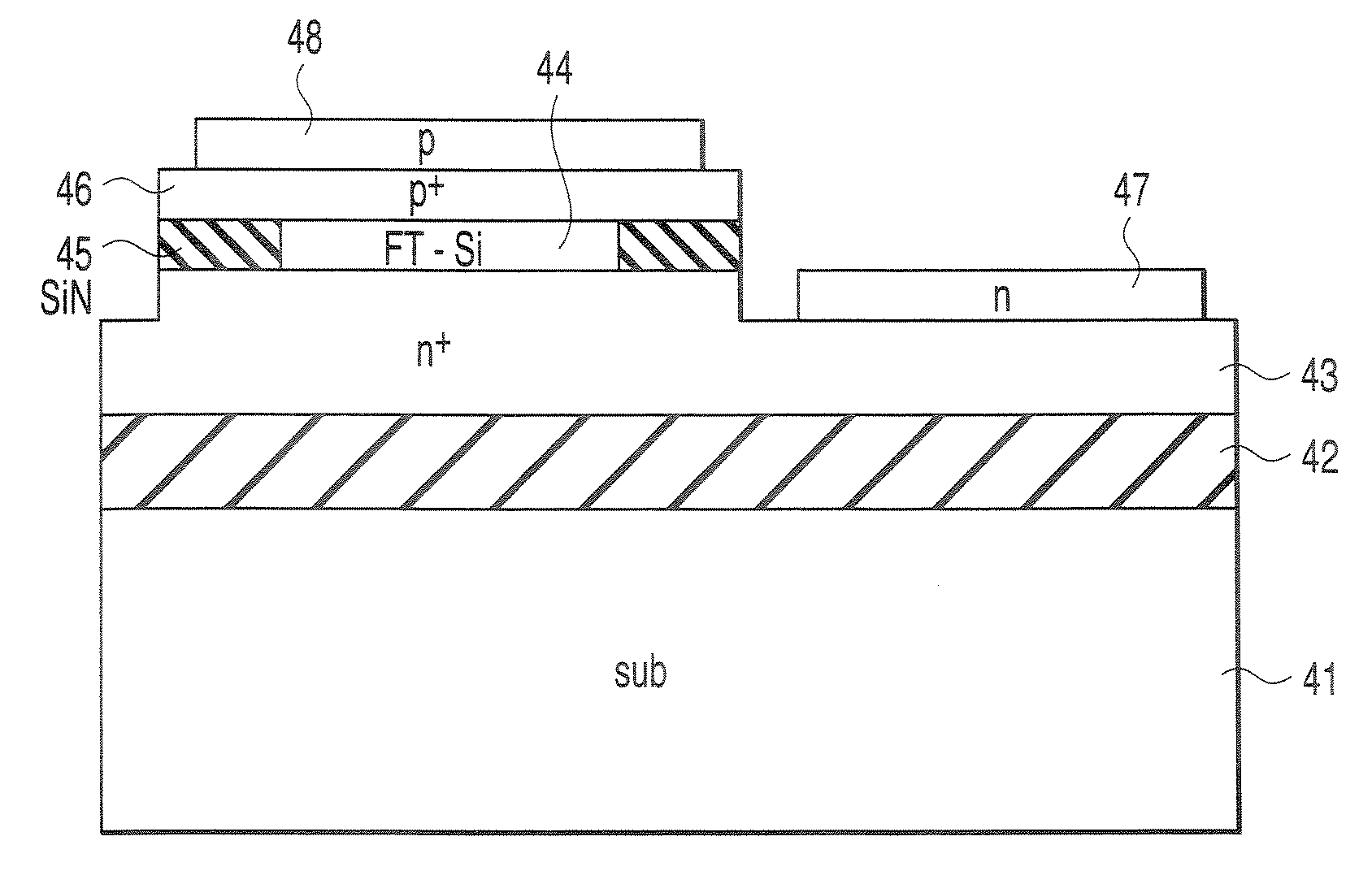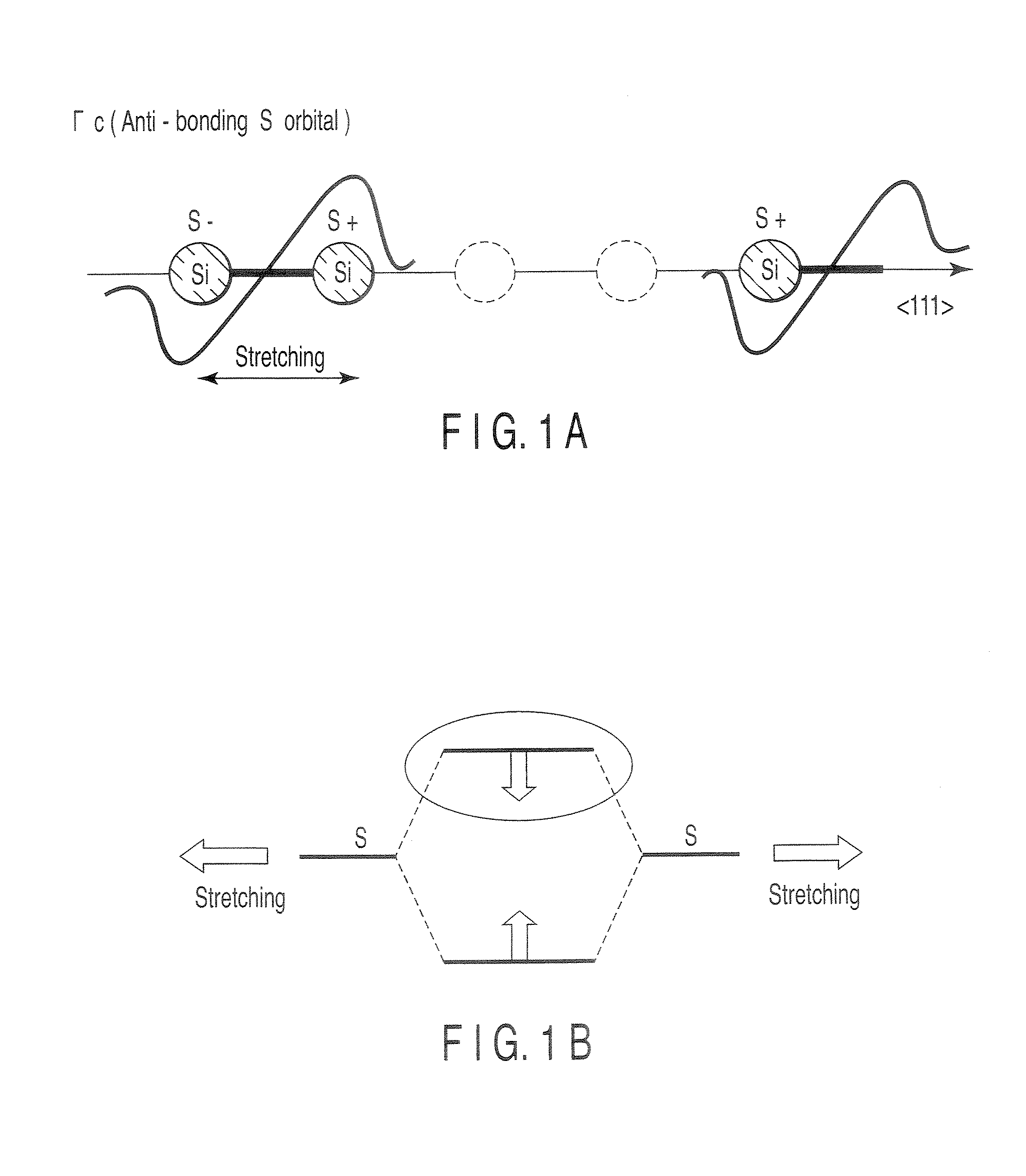Semiconductor light-emitting material and light emitting device
a technology of light-emitting devices and semiconductors, applied in the direction of semiconductor lasers, luminescent compositions, chemistry apparatuses and processes, etc., can solve the problems of silicon, a typical electronic material supporting electronics, unsuitable for optical applications, and theoretically impossible for silicon light-emitting devices based on these techniques to emit light at high efficiency and high speed
- Summary
- Abstract
- Description
- Claims
- Application Information
AI Technical Summary
Problems solved by technology
Method used
Image
Examples
first embodiment
(First Embodiment)
[0125]In this embodiment, a vertical type silicon light emitting device shown in FIG. 6A in which bond stretching is introduced in the active layer will be described. The n+ layer 1 is formed on a (111) silicon substrate (not shown). Then, the active layer 2 formed on the n+ layer 1 is patterned, followed by burying the SiN layer 3 in the region surrounding the active layer 2. By performing a thermal process, compressive stress is applied to the active layer 2 from the SiN layer 3 so that the active layer 2 is stretched in the direction, i.e., in the normal direction to the film plane. It can be confirmed by Raman spectroscopy that about several percent of bond stretching is introduced in the direction. Then, the p+ layer 4 is formed on the active layer 2. In order to forcedly inject a current into the active layer 2, it is desirable to use a metal with a small work function for the n-electrode. In this case, a SrSi electrode is used as an example.
[0126]EL emissi...
second embodiment
(Second Embodiment)
[0133]In this embodiment, a vertical type silicon light emitting device shown in FIG. 6A in which bond stretching is introduced in the active layer comprising FT-Si will be described. The light emitting device in this embodiment can be manufactured by processes similar to those in the first embodiment except for the method of forming the active layer. The method of forming the active layer will be described below. Phosphorus atoms (P) used as the heteroatom S substituted for a lattice site of silicon, and fluorine atoms (F) used as the heteroatom I inserted into an interstitial site are ion-implanted simultaneously into the active layer. Each of the P concentration and the F concentration is about 2.5×1020 / cm3. When the active layer is annealed at about 500° C. for a short time, the P atoms are substituted for lattice sites and the F atoms are inserted into interstitial sites adjacent to the P atoms at the lattice sites, so that stable PF pairs are formed. Whether...
third embodiment
(Third Embodiment)
[0138]In this embodiment, a vertical type silicon light emitting device shown in FIG. 6A in which bond stretching is introduced in the active layer comprising FT-Si will be described. The light emitting device in this embodiment can be manufactured by processes similar to those in the second embodiment, except that another FT-Si is used as the material for the active layer. The method of forming the active layer will be described below. Indium atoms (In) are used as the heteroatom S substituted for a lattice site of silicon, and sodium atoms (Na) are used as the heteroatom I inserted into an interstitial site. Each of the In concentration and the Na concentration is about 5×1020 / cm3 and the InNa pair concentration is about 5×1020 / cm3. Whether the InNa pair in the pendant type FT structure is formed in the active layer can be confirmed by microscopic infrared spectroscopy. The natural vibration mode of the InNa pair appears in the vicinity of 140 to 180 cm−1.
[0139]A...
PUM
 Login to View More
Login to View More Abstract
Description
Claims
Application Information
 Login to View More
Login to View More - R&D
- Intellectual Property
- Life Sciences
- Materials
- Tech Scout
- Unparalleled Data Quality
- Higher Quality Content
- 60% Fewer Hallucinations
Browse by: Latest US Patents, China's latest patents, Technical Efficacy Thesaurus, Application Domain, Technology Topic, Popular Technical Reports.
© 2025 PatSnap. All rights reserved.Legal|Privacy policy|Modern Slavery Act Transparency Statement|Sitemap|About US| Contact US: help@patsnap.com



